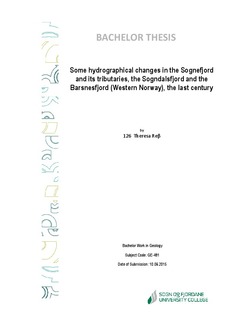| dc.description.abstract | The thesis investigates the changes in hydrography, especially in salinity and temperature at the Sognefjord and its tributaries Sogndalsfjord and Barsnesfjord during the last century. Thereby in particular a potential correlation with the building of the water power plants since the 1960s and the climatic changes is examined. Thus several data sets regarding the different water bodies’ salinities and temperatures are analyzed, especially focusing on the upper water layers and the seasonal features. Overall there is a general drop in salinity observed by comparing the period before the building of the water power plants around 1960 and the period after finishing the largest plants in 1989.
Thus it accounts for 0.77‰ decrease at the Sognesjøen and 5.27‰ at the Sogndalsfjord during winter time at 0 m depth. Regarding the summer period a slightly smaller drop of 0.15‰ is visible at the Sognesjøen.
Against that the winter and summer temperatures also show significant changes, in particular a magnifying trend of the changes with going deeper into the fjord. Thus the winter values rise at 0.32°C at the Sognesjøen while they drop around 0.68°C at the Sogndalsfjord in 0 m depth. Regarding the summer period an increase of around 1.12°C is visible at the Sognesjøen.
The salinity changes, in particular in winter time, originated by a changed inflow of dammed water through the water power plants but partly also by general increase in the average amount of precipitation.
Regarding the temperature changes, these are related to both, simultaneous increases in air temperature but also effects due to inflow of different temperate water masses through the water power plants. The increasing effect with going deeper into the fjord is owing to the “Land-Ocean”-Effect, the difference in heat penetration in the single regions and the darkening of the coastal water. | nb_NO |
